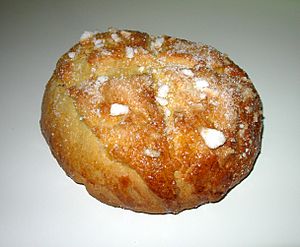Mouna facts for kids

Picture of Mouna
|
|
| Type | Bread |
|---|---|
| Place of origin | Originally Algeria, today more common in France and Israel |
| Region or state | Maghreb, France, Israel, and the Algerian Jewish diaspora |
| Created by | Algerian Jewish community |
| Serving temperature | Traditionally for Shabbat, Mimouna, and other Jewish holidays |
| Main ingredients | Eggs, fine white flour, water, yeast, sugar, anise, orange zest or juice, lemon zest of juice, sesame seeds, confectioner's sugar and salt |
Mouna, also known as Mona, is a delicious sweet bread. It comes from Algerian Jews, who are part of the Sephardi Jews. Mouna is a bit like other breads such as challah or brioche. People traditionally eat Mouna during Jewish holidays like Mimouna and Shabbat. Today, you can often find Mouna in France and Israel. This bread is sweet and rich, made with oil and eggs. It often has flavors like anise, sesame, or orange.
What's in a Name?
The name Mouna comes from the Jewish holiday called Mimouna. This is a special day celebrated by Maghrebi Jews. It marks the end of the Passover holiday. On Mimouna, people enjoy a big feast of sweets and baked goods. The word Mouna might also come from the Hebrew word emunah. This word means faith.
About Mouna Bread
Mouna is a very popular bread. It is especially loved in Algerian Jewish cooking. You can also find it in Moroccan Jewish and Tunisian Jewish food. Because many Maghrebi Jews live there, Mouna is also popular in French Jewish and Israeli cuisine.
Mouna is used in a similar way to Challah bread. Other Jewish communities use Challah for Shabbat and other holidays. Mouna is served for Shabbat and holidays like Mimouna. It is also eaten when people break their fast after Yom Kippur. Mouna is a soft and sweet bread. Sometimes, it even has a tasty jam filling in the middle.
How Mouna is Made
Mouna is often baked for Jewish holidays and special events. It is a favorite in the Algerian Jewish community. To make Mouna, you start with a rich dough. The dough is made from flour, eggs, cooking oil, water, sugar, and salt. Sometimes, people add anise seeds or orange and lemon zest or juice for extra flavor.
The dough is then kneaded and left to rise. After it rises, it is shaped into small, individual balls. These dough balls are placed together in a baking pan. They are then brushed with an egg wash to make them shiny. Often, Mouna is topped with powdered sugar or sesame and anise seeds. The bread is then baked until it is golden. When it's ready, Mouna can look a bit like kubaneh, a bread from Yemenite Jewish cooking. It can also look like American monkey bread.
See also
 In Spanish: Muna (brioche) para niños
In Spanish: Muna (brioche) para niños

